|
|
|
China Tours
|
| Beijing |
|
Shanghai |
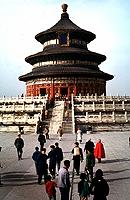 Bejing is the capital of China. For the last thousand years, the
drama of China's imperial history was played out here, with the emperor sitting enthroned
at the centre of the Chinese universe. Today's city is a very different one, but it
remains spiritually and politically the heart of the country. Between the swathes of
concrete and glass, you'll find some of the finest temples and the grandest remnants of
the Imperial age.First impressions are of an almost inhuman vastness, but Beijing is a
city that almost everyone ultimately enjoys, though it requires patience and planning to
do it justice. Bejing is the capital of China. For the last thousand years, the
drama of China's imperial history was played out here, with the emperor sitting enthroned
at the centre of the Chinese universe. Today's city is a very different one, but it
remains spiritually and politically the heart of the country. Between the swathes of
concrete and glass, you'll find some of the finest temples and the grandest remnants of
the Imperial age.First impressions are of an almost inhuman vastness, but Beijing is a
city that almost everyone ultimately enjoys, though it requires patience and planning to
do it justice.
Learn
more about Bejing |
|
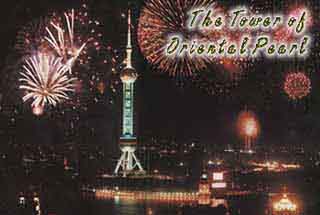 Shanghai lies on the west bank of the Huangpu
Jiang river, which flows into the Changjiang (Yangtze) 28 km farther upstream. The
northern part of Shanghai is separated from the rest of the city by the Wusong Jiang
river. Shanghai is a special city in every respect. Only 50 years ago, it was still
considered one of the most important metropolises of the world, as the trading and banking
center of Asia. Foreigners lent Shanghai its appearance, making it more western than
Chinese. Twenty-story-high buildings reach skyward; there are vast hotel complexes, villas
and palaces that a visitor from the West can more easily identify than a temple, for they
were built according to Western architectural style by former business and military men. Shanghai lies on the west bank of the Huangpu
Jiang river, which flows into the Changjiang (Yangtze) 28 km farther upstream. The
northern part of Shanghai is separated from the rest of the city by the Wusong Jiang
river. Shanghai is a special city in every respect. Only 50 years ago, it was still
considered one of the most important metropolises of the world, as the trading and banking
center of Asia. Foreigners lent Shanghai its appearance, making it more western than
Chinese. Twenty-story-high buildings reach skyward; there are vast hotel complexes, villas
and palaces that a visitor from the West can more easily identify than a temple, for they
were built according to Western architectural style by former business and military men.
Learn
more about Shanghai |
| Xi'an |
|
Guangzhou |
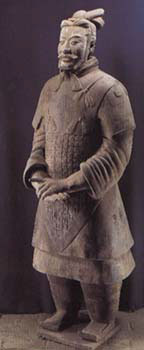 Xi'an, the historical city, was called Chang'an in
ancient times, and is now the capital of Shaanxi province.
Xi'an is situated in the centre
of Weihe Plain with towering and verdant Mt.Qinling in the south, meandering and rolling
Beishan mountain system in the north and eight rivers around it, all of which are at Guang
Zhong (the centre of passes) Plain. In history it was famous for being called "a gold
city stretching a thousand li" with fertile soil, mild climate, adequate rainfall and
rich products. Xi'an has a long history. As early as in the primitive society, humanity
lived and multiplied here. In ancient Chinese history, it served as a capital for twelve
dynasties, including the Western Zhou, Qin, Western Han, Sui and Tang dynasties, spanning
over 1120 years. Learn more about Xi'an Xi'an, the historical city, was called Chang'an in
ancient times, and is now the capital of Shaanxi province.
Xi'an is situated in the centre
of Weihe Plain with towering and verdant Mt.Qinling in the south, meandering and rolling
Beishan mountain system in the north and eight rivers around it, all of which are at Guang
Zhong (the centre of passes) Plain. In history it was famous for being called "a gold
city stretching a thousand li" with fertile soil, mild climate, adequate rainfall and
rich products. Xi'an has a long history. As early as in the primitive society, humanity
lived and multiplied here. In ancient Chinese history, it served as a capital for twelve
dynasties, including the Western Zhou, Qin, Western Han, Sui and Tang dynasties, spanning
over 1120 years. Learn more about Xi'an |
|
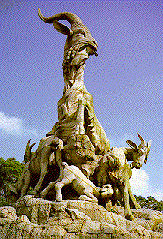 Guangzhou,
located at the north of the Pearl River delta, is an important trading center as well as a
busy port and the capital city of the province of Guandong . The city has an area of over
16,000 square kilometers and a population of 6.7 million. The climate of Guangzhou is
sub-tropical. The average year-round temperature is 22C. August is the hottest month, with
an average temperature of 28C. January is the coldest month, with an average of 13C. The
rainy season falls between April and August. Average annual rainfall is 1,720 mm. There
are a lot of interesting legends concerning its past. One of the beautiful stories which
gives the city its name Goat Town says that five gods riding on five goats brought the
first grain to the city. So, it is also known as the City of Five Goats. Guangzhou,
located at the north of the Pearl River delta, is an important trading center as well as a
busy port and the capital city of the province of Guandong . The city has an area of over
16,000 square kilometers and a population of 6.7 million. The climate of Guangzhou is
sub-tropical. The average year-round temperature is 22C. August is the hottest month, with
an average temperature of 28C. January is the coldest month, with an average of 13C. The
rainy season falls between April and August. Average annual rainfall is 1,720 mm. There
are a lot of interesting legends concerning its past. One of the beautiful stories which
gives the city its name Goat Town says that five gods riding on five goats brought the
first grain to the city. So, it is also known as the City of Five Goats.
Learn more about Guangzhou |
| Chongqing |
|
Guilin |
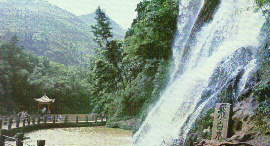 Chongqing
is a city located in the sourtheastern part of the Sichuan Basin. It is also called
Yu for short. It lies at the confluence of the Jaling and Yangtze rivers and covers an
area of 22341 sq. km. It is heavily populated. Food is typically spicy and the real
traditional Sichuan cuisine is found there. Chongqing
is a city located in the sourtheastern part of the Sichuan Basin. It is also called
Yu for short. It lies at the confluence of the Jaling and Yangtze rivers and covers an
area of 22341 sq. km. It is heavily populated. Food is typically spicy and the real
traditional Sichuan cuisine is found there.Learn more about Chongqing |
|
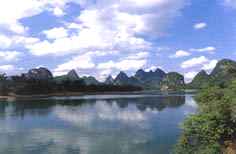 The scenery of Guilin has been called the
finest under heaven. Situated in the northeast of Guangxi Zhuang Autonomous Region, Guilin
City is South China's shining pearl , with verdant mountains , elegant waters ,
magnificent crags and fantastic caverns. It has a total area of 2,000 sq.km. and a
population of 680.000 (the urban area being 54 sq.km. and the population
300,000).Guilin has a history of more than 2,000 years.In the 6th year of Yuanding During
the reign of Emperor Wu of the Han Dynasty ( 1 1 1 BC), Guilin was a county, called Shi An
County, and from the Song Dynasty to the Qing Dynasty, it was the political, economic and
cultural centre of Guangxi. In 1921,the North Expeditionary Army led by Sun Zhongshan (Dr.
Sun Yat-sen) joined forces In Guilin,and the headquarters was sited in the Royal Palace at
the foot Of the Solitary Beauty Peak. The city acquired its present name in the year of
1940. The scenery of Guilin has been called the
finest under heaven. Situated in the northeast of Guangxi Zhuang Autonomous Region, Guilin
City is South China's shining pearl , with verdant mountains , elegant waters ,
magnificent crags and fantastic caverns. It has a total area of 2,000 sq.km. and a
population of 680.000 (the urban area being 54 sq.km. and the population
300,000).Guilin has a history of more than 2,000 years.In the 6th year of Yuanding During
the reign of Emperor Wu of the Han Dynasty ( 1 1 1 BC), Guilin was a county, called Shi An
County, and from the Song Dynasty to the Qing Dynasty, it was the political, economic and
cultural centre of Guangxi. In 1921,the North Expeditionary Army led by Sun Zhongshan (Dr.
Sun Yat-sen) joined forces In Guilin,and the headquarters was sited in the Royal Palace at
the foot Of the Solitary Beauty Peak. The city acquired its present name in the year of
1940.
Learn more about Guilin |
| Nanjing |
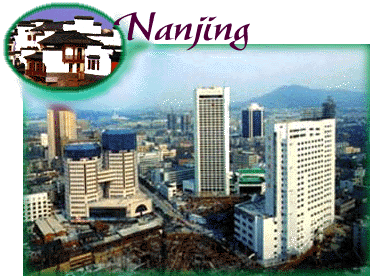 Nanjing, an ancient metropolis of six different dynasties, is a city with
mountains, waters and green trees. The ancestors of Nanjingers can be dated back to the
apemen who lived in caves at Tangshan Hill hundreds of thousands of years ago. About 5000 to 6000 years ago some people came to the
tableland by waters and made a living by fishing, hunting or farming. Nanjing took shape
at the confluence of the Changjiang (Yangtse) and Qinhuaihe rivers. Goujian, King of Yue
State, had a city built by the Qinhuaihe and named it Yuecheng 2500 years ago.
Later Chu State had a city called Jinling erected at the foot of Qingliangshan Hill.
Yuecheng and Jinling were the embryonic forms of Nanjing. The Yangtse River rushes from
southwest towards the Stone Hill which is strategically located and difficult of access.
Sun Quan, King of State Wu, had his military fortress built here with the giant rocks by
the river as the wall and named it the Stone City, which is also called the Ghost Face
City because of its grotesque shape. Ever since then, Jinling, Shitou (Stone) have been
the ancient aliases of Nanjing. Nanjing, an ancient metropolis of six different dynasties, is a city with
mountains, waters and green trees. The ancestors of Nanjingers can be dated back to the
apemen who lived in caves at Tangshan Hill hundreds of thousands of years ago. About 5000 to 6000 years ago some people came to the
tableland by waters and made a living by fishing, hunting or farming. Nanjing took shape
at the confluence of the Changjiang (Yangtse) and Qinhuaihe rivers. Goujian, King of Yue
State, had a city built by the Qinhuaihe and named it Yuecheng 2500 years ago.
Later Chu State had a city called Jinling erected at the foot of Qingliangshan Hill.
Yuecheng and Jinling were the embryonic forms of Nanjing. The Yangtse River rushes from
southwest towards the Stone Hill which is strategically located and difficult of access.
Sun Quan, King of State Wu, had his military fortress built here with the giant rocks by
the river as the wall and named it the Stone City, which is also called the Ghost Face
City because of its grotesque shape. Ever since then, Jinling, Shitou (Stone) have been
the ancient aliases of Nanjing.
Learn
more about Nanjing |
|